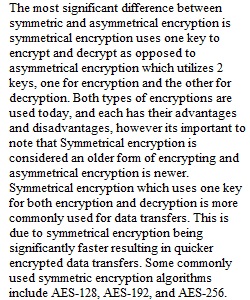


Q Compare asymmetric and symmetric cryptography, specifically focusing on strengths and weaknesses of both. Your assignment must be at minimum 1 paragraph in length, maximum 2 paragraphs with proper citations (APA). Rubric Weekly Reading Writing Assignments Weekly Reading Writing Assignments Criteria Ratings Pts This criterion is linked to a Learning OutcomeQuality 25 to >22.75 pts DISTINGUISHED Provides a well-thought out journal entry reflective of a complete understanding of assigned readings. 22.75 to >20.5 pts PROFICIENT Provides thoughts and ideas gleaned from chapter reading in an orderly and clear fashion. 20.5 to >18.25 pts SATISFACTORY Journal entry is entered with fragmented thoughts on topics and ideas presented in textbook. 18.25 to >16.0 pts EMERGING Provides minimal entry in journal entry. 16 to >0 pts UNSATISFACTORY Does not submit Journal. 25 pts This criterion is linked to a Learning OutcomeContent 25 to >22.75 pts Reveals a solid understanding of the topic and ideas. Thoughts are organized and expressed clearly. Uses examples to illustrate comprehension of material presented in chapter readings. 22.75 to >20.5 pts Reveals adequate understanding of the topics and ideas in respective chapter reading assignments. 20.5 to >18.25 pts Reveals a restricted understanding of the topic limited to information found in chapter summary. 18.25 to >16.0 pts Adds little to reveal comprehension of readings. 16 to >0 pts Does not add content to Journal assignment. 25 pts This criterion is linked to a Learning OutcomeCritical Thinking 25 to >22.75 pts Offers a critical analysis of readings, and discusses topics and ideas in an orderly and coherent fashion. Supplements analysis with real-world examples. 22.75 to >20.5 pts Presents topics and ideas discussed in text readings with examples related to real-world experiences. 20.5 to >18.25 pts Presents topics and ideas discussed in text readings, but only in summary format. 18.25 to >16.0 pts Provides no evidence of reading or comprehension. 16 to >0 pts Does not submit Journal. 25 pts This criterion is linked to a Learning OutcomeWriting Style 25 to >22.75 pts Highly skilled presentation of ideas. Work exceeds expectations for this level of student. Absolutely no errors in spelling, punctuation, or grammar noted. 22.75 to >20.5 pts Explicitly presents ideas. Work appropriate for this level of student. No spelling or grammar errors noted. A few minor punctuation errors identified. 20.5 to >18.25 pts Able to present ideas. Comes close to expectations for work at this level. Some punctuation and spelling errors but no errors in grammar identified. 18.25 to >16.0 pts Limited ability to convey ideas. Below expectations of work at this level. Errors noted in spelling, punctuation, and grammar. 16 to >0 pts Does not submit Journal. 25 pts Total Points: 100 PreviousNext
View Related Questions